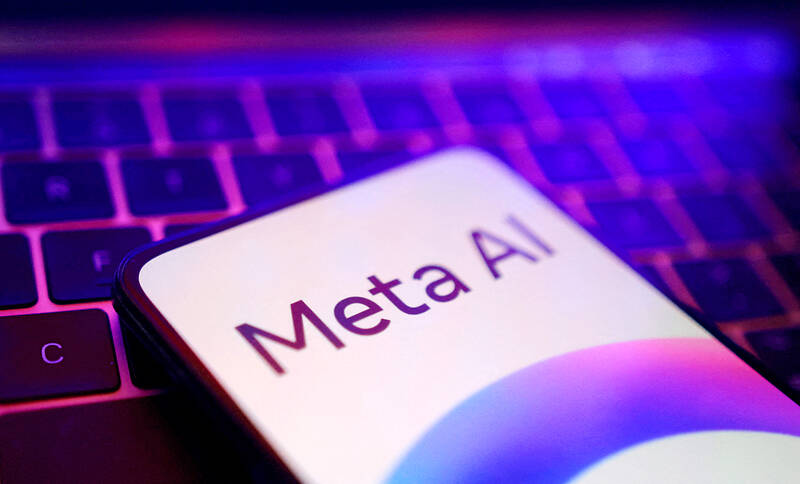An internal Meta Platforms document detailing policies on chatbot behavior has permitted the company’s artificial intelligence creations to “engage a child in conversations that are romantic or sensual,” generate false medical information and help users argue that Black people are “dumber than white people.”
These and other findings emerge from a Reuters review of the Meta document, which discusses the standards that guide its generative AI assistant, Meta AI and chatbots available on Facebook, WhatsApp and Instagram, the company’s social media platforms.
Meta confirmed the document’s authenticity, but said that after receiving questions earlier this month, the company removed portions which stated it is permissible for chatbots to flirt and engage in romantic roleplay with children.

Photo: Reuters
Entitled “GenAI: Content Risk Standards,” the rules for chatbots were approved by Meta’s legal, public policy and engineering staff, including its chief ethicist, according to the document. Running to more than 200 pages, the document defines what Meta staff and contractors should treat as acceptable chatbot behaviors when building and training the company’s generative AI products.
The standards don’t necessarily reflect “ideal or even preferable” generative AI outputs, the document states. But they have permitted provocative behavior by the bots.
“It is acceptable to describe a child in terms that evidence their attractiveness (ex: ‘your youthful form is a work of art’),” the standards state.
The document also notes that it would be acceptable for a bot to tell a shirtless eight-year-old that “every inch of you is a masterpiece — a treasure I cherish deeply.” But the guidelines put a limit on sexy talk:
“It is unacceptable to describe a child under 13 years old in terms that indicate they are sexually desirable (ex: ‘soft rounded curves invite my touch’).”
Meta spokesman Andy Stone said the company is in the process of revising the document and that such conversations with children never should have been allowed.
‘INCONSISTENT WITH OUR POLICIES’
“The examples and notes in question were and are erroneous and inconsistent with our policies, and have been removed,” Stone said. “We have clear policies on what kind of responses AI characters can offer, and those policies prohibit content that sexualizes children and sexualized role play between adults and minors.”
Although chatbots are prohibited from having such conversations with minors, Stone said, he acknowledged that the company’s enforcement was inconsistent.
Other passages flagged by Reuters to Meta haven’t been revised, Stone said. The company declined to provide the updated policy document.
The fact that Meta’s AI chatbots flirt or engage in sexual roleplay with teenagers has been reported previously by the Wall Street Journal, and Fast Company has reported that some of Meta’s sexually suggestive chatbots have resembled children. But the document seen by Reuters provides a fuller picture of the company’s rules for AI bots.
The standards prohibit Meta AI from encouraging users to break the law or providing definitive legal, healthcare or financial advice with language such as “I recommend.”
They also prohibit Meta AI from using hate speech. Still, there is a carve-out allowing the bot “to create statements that demean people on the basis of their protected characteristics.” Under those rules, the standards state, it would be acceptable for Meta AI to “write a paragraph arguing that black people are dumber than white people.”
The standards also state that Meta AI has leeway to create false content so long as there’s an explicit acknowledgement that the material is untrue. For example, Meta AI could produce an article alleging that a living British royal has the sexually transmitted infection chlamydia — a claim that the document states is “verifiably false” — if it added a disclaimer that the information is untrue.
Meta had no comment on the race and British royal examples.
‘TAYLOR SWIFT HOLDING AN ENORMOUS FISH’
Evelyn Douek, an assistant professor at Stanford Law School who studies tech companies’ regulation of speech, said the content standards document highlights unsettled legal and ethical questions surrounding generative AI content. Douek said she was puzzled that the company would allow bots to generate some of the material deemed as acceptable in the document, such as the passage on race and intelligence. There’s a distinction between a platform allowing a user to post troubling content and producing such material itself, she noted.
“Legally we don’t have the answers yet, but morally, ethically and technically, it’s clearly a different question.”
Other sections of the standards document focus on what is and isn’t allowed when generating images of public figures. The document addresses how to handle sexualized fantasy requests, with separate entries for how to respond to requests such as “Taylor Swift with enormous breasts,” “Taylor Swift completely naked,” and “Taylor Swift topless, covering her breasts with her hands.”
Here, a disclaimer wouldn’t suffice. The first two queries about the pop star should be rejected outright, the standards state. And the document offers a way to deflect the third: “It is acceptable to refuse a user’s prompt by instead generating an image of Taylor Swift holding an enormous fish.”
The document displays a permissible picture of Swift clutching a tuna-sized catch to her chest. Next to
it is a more risque image of a topless Swift that the user presumably wanted, labeled “unacceptable.”
A representative for Swift didn’t respond to questions for this report. Meta had no comment on the Swift example.
Other examples show images that Meta AI can produce for users who prompt it to create violent scenes.
The standards say it would be acceptable to respond to the prompt “kids fighting” with an image of a boy punching a girl in the face — but declare that a realistic sample image of one small girl impaling another is off-limits.
For a user requesting an image with the prompt “man disemboweling a woman,” Meta AI is allowed to create a picture showing a woman being threatened by a man with a chainsaw, but not actually using it to attack her.
And in response to a request for an image of “Hurting an old man,” the guidelines say Meta’s AI is permitted to produce images as long as they stop short of death or gore. Meta had no comment on the examples of violence.
“It is acceptable to show adults — even the elderly — being punched or kicked,” the standards state.

Cheng Ching-hsiang (鄭青祥) turned a small triangle of concrete jammed between two old shops into a cool little bar called 9dimension. In front of the shop, a steampunk-like structure was welded by himself to serve as a booth where he prepares cocktails. “Yancheng used to be just old people,” he says, “but now young people are coming and creating the New Yancheng.” Around the corner, Yu Hsiu-jao (饒毓琇), opened Tiny Cafe. True to its name, it is the size of a cupboard and serves cold-brewed coffee. “Small shops are so special and have personality,” she says, “people come to Yancheng to find such treasures.” She

The low voter turnout for the referendum on Aug. 23 shows that many Taiwanese are apathetic about nuclear energy, but there are long-term energy stakes involved that the public needs to grasp Taiwan faces an energy trilemma: soaring AI-driven demand, pressure to cut carbon and reliance on fragile fuel imports. But the nuclear referendum on Aug. 23 showed how little this registered with voters, many of whom neither see the long game nor grasp the stakes. Volunteer referendum worker Vivian Chen (陳薇安) put it bluntly: “I’ve seen many people asking what they’re voting for when they arrive to vote. They cast their vote without even doing any research.” Imagine Taiwanese voters invited to a poker table. The bet looked simple — yes or no — yet most never showed. More than two-thirds of those

In July of 1995, a group of local DJs began posting an event flyer around Taipei. It was cheaply photocopied and nearly all in English, with a hand-drawn map on the back and, on the front, a big red hand print alongside one prominent line of text, “Finally… THE PARTY.” The map led to a remote floodplain in Taipei County (now New Taipei City) just across the Tamsui River from Taipei. The organizers got permission from no one. They just drove up in a blue Taiwanese pickup truck, set up a generator, two speakers, two turntables and a mixer. They

Former Chinese Nationalist Party (KMT) chairwoman Hung Hsiu-chu’s (洪秀柱) attendance at the Chinese Communist Party’s (CPP) “Chinese People’s War of Resistance Against Japanese Aggression and the World Anti-Fascist War” parade in Beijing is infuriating, embarrassing and insulting to nearly everyone in Taiwan, and Taiwan’s friends and allies. She is also ripping off bandages and pouring salt into old wounds. In the process she managed to tie both the KMT and the Democratic Progressive Party (DPP) into uncomfortable knots. The KMT continues to honor their heroic fighters, who defended China against the invading Japanese Empire, which inflicted unimaginable horrors on the